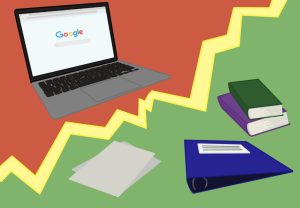Digital learning more effective than paper materials
August 26, 2022
Over the past few years, Midtown has moved away from paper learning and more towards an online-based curriculum. This transition to digital learning is a significant improvement over paper methods.
Paper learning relies on students being present in class to listen to lectures, take notes, do assignments and view presentations. If a student is out of class, they have no way of keeping up with the material or completing work. On the other hand, digital education is run through applications like Schoology, where students join their teacher’s online class to gain access to materials, making it easy for students who are absent to catch up on missed work.
This centralized location where all classroom resources can be found has numerous benefits for both students and teachers. One such benefit is that students can log into their computers at the beginning of the day and be instantly presented with everything they need to learn. There is no waiting for a handout to be passed out, for other students to be ready, or for a presentation slide to be flipped. Students can dive into their work without the unnecessary delays and hassles that paper learning causes. Teachers don’t have to worry about whether all students have papers or if students missed any directions. In a digital classroom, teachers can spend more time answering questions, providing individual help and having productive discussions.
Most importantly, switching from paper to digital learning opens the door to a near limitless supply of free educational resources. Students gain access to lectures by world-renowned educators, supplemental programs like Khan Academy, informational websites like Encyclopedia Britannica and study tools such as Quizlet or Duolingo. All these extra resources allow students to take control of their learning in a way that isn’t possible using paper.
However, the helpfulness of these resources is not limited to just students. Teachers gain access to new teaching methods and lesson plans from around the world. With these assets, teachers can better engage students with new types of lessons and different ways of learning information. Furthermore, teachers can quickly gauge their class’s understanding of a topic with a short quiz or progress check online. On paper, it can take hours or days for a teacher to grade and review all their students’ assessments. An online quiz is graded instantly, saving teachers countless hours and granting immediate feedback that will help them assess where their students are, what they need help on and how they need to adjust.
Although the use of computers can introduce added distractions like online games and internet browsing, these problems are effectively mitigated by placing restrictions on internet usage. Atlanta Public Schools blocks access to gaming websites, social media and YouTube. Additionally, teachers are provided with the tool Securely, an internet filter that monitors and restricts the tabs students access. By continuing to maintain and adapt these restrictions, APS can eliminate the distractions that come with learning online.The goal of high school is to prepare students for the real world, and the real world is becoming increasingly digitized. Those graduating with the ability to effectively navigate in an online environment have a distinct advantage over those who have spent their entire four years reading out of a textbook. Thus if students are to be well-prepared for life post-high school, then digital learning is a must.







